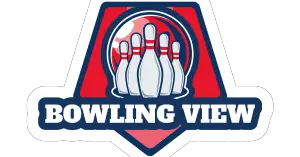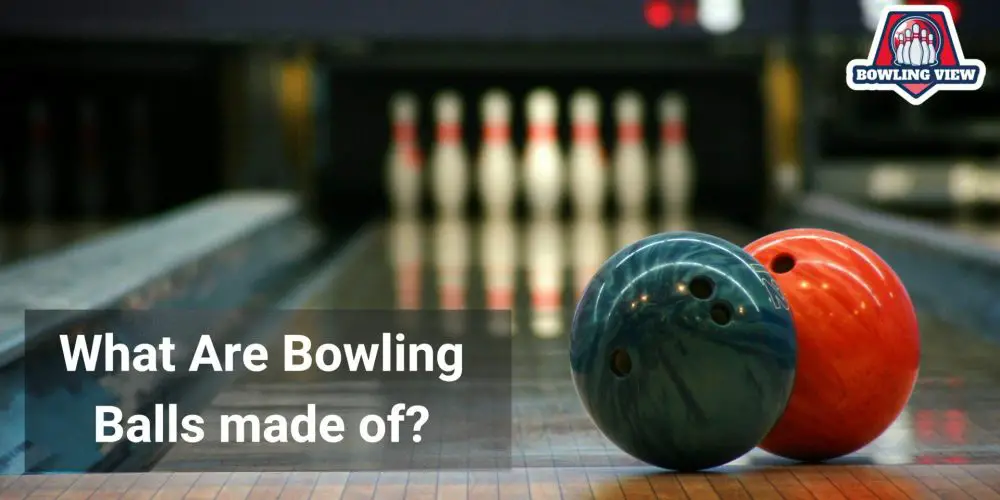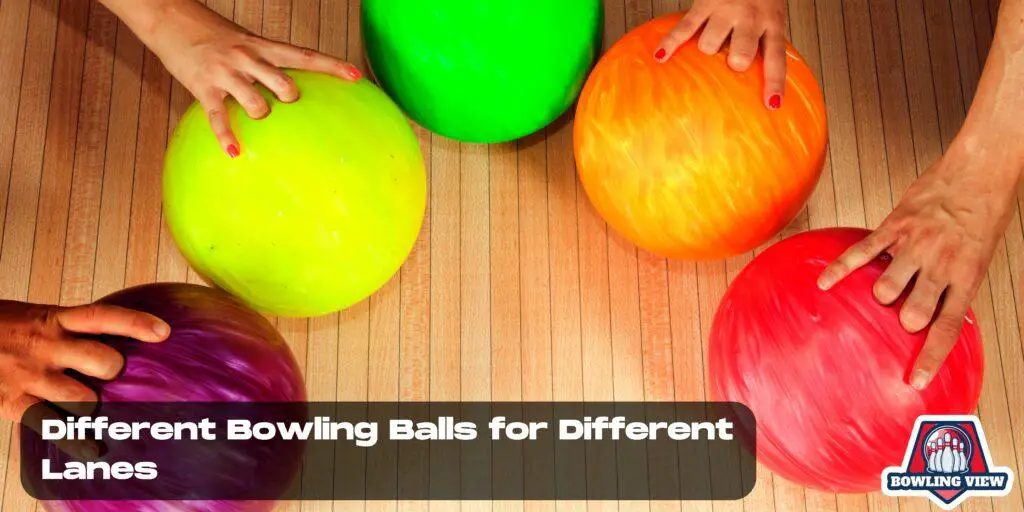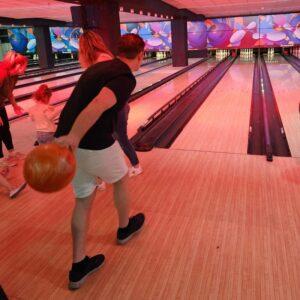We all know what a bowling ball is – that heavy spherical object we aim at the pins at the end of a bowling lane. But have you ever stopped to wonder, What are bowling balls made of?
You might be surprised to discover that the answer goes far beyond simple ‘rubber’ or ‘plastic.’ Therefore, in this article, we will dive into the fascinating world of bowling balls and uncover the secrets hiding within.
History of Bowling Balls: From Wood to Resin
Firstly, our journey started centuries ago when bowling balls were made out of wood. You heard right! The early bowlers used wooden balls, which later transitioned to the rubber ball era.
Early Materials and Design
In the infancy of the sport, around the time American bowling began, bowling balls were made out of wood.
As you can imagine, these heavy balls weren’t exactly ideal for a perfect game. Additionally, the variation in the wood’s density and imperfections often led to unpredictable ball motion.
Transition into Modern Materials
Next, the evolution from wooden to rubber bowling balls was a significant turning point in the sport’s history.
The rubber ball offered increased durability and better performance. Despite the transition to modern materials such as reactive resin, urethane, and polyester, some bowlers still enjoy the nostalgia and unique feel of rubber bowling balls.
Anatomy of a Bowling Ball: Unveiling the Inner Secrets
Peel back the outer shell of a bowling ball, and you’re in for a surprise. Modern bowling balls contain a core and a coverstock, each playing a crucial role in the ball’s performance.
The Core: The Heart of the Ball
In the process of creating a bowling ball, the core, often referred to as “the heart of the ball,” is the first part that gets made.
Manufacturers can make the core of a bowling ball from various materials, including dense plastic or ceramic, and they can design it in such a way that it affects the overall symmetry or dynamics of the ball’s motion.
Different Types of Cores
There are primarily two types of cores – pancake and dynamic. The former, often found in plastic balls, is a round, flat-weight block positioned near the ball’s surface. Dynamic cores, used in reactive and resin balls, have an irregular shape, contributing to the ball’s hook potential.
The function of the Core
Have you ever wondered why your ball connects at the end of the lane? This is the core doing its job!
The core’s weight distribution affects the ball’s spin and movement as it travels down the lane, making the choice of core type an essential consideration for any serious bowler.
Coverstock: The Interface between Ball and Lane
The coverstock, or the outer surface of the ball, is the part that comes into direct contact with the lane surface. There are different types of coverstocks – plastic (or polyester), urethane, and reactive resin.
Types of Coverstocks
- Plastic/Polyester: The least expensive material, often found in spare balls or house balls, offers minimal friction and hook potential.
- Urethane: Urethane bowling balls offer more friction than plastic, leading to a smoother and more controlled hook.
- Reactive Resin: Reactive resin balls, introduced in the 90s, have even higher friction and hook potential, making them a popular choice for many bowlers.
Another interesting read: Why are bowling balls scented?.
Importance of the Coverstock
The type of coverstock determines the ball’s reaction on the lane. A urethane ball, for instance, will behave differently from a reactive resin ball due to the difference in friction between the ball and the lane.
The Making of a Bowling Ball: A Journey from Concept to Completion
From design to drilling, creating a bowling ball is a fascinating process combining art and science. Here’s how a new bowling ball is born.
1. Designing Stage
The ball’s motion, hook potential, and performance characteristics are planned at this stage. Manufacturers consider the core shape, coverstock material, and overall ball design.
2. Building the Core
The core is made using a dense material, such as ceramic or plastic-like material, and is shaped according to the design specifications.
3. Applying the Coverstock
Manufacturers form the ball’s outer shell by pouring the coverstock material around the core. This shell is then allowed to harden and set.
4. Crafting the Outer Shell
Once the coverstock has been set, the ball is removed from the mold and goes through a series of grinding and polishing processes to create a smooth surface on the ball.
5. Drilling Finger Holes
Depending on the bowler’s grip style and hand measurements, technicians drill the appropriate finger holes into the ball.
6. Polishing and Finishing
The final step involves additional polishing and finishing to give the ball its final appearance and texture.
Different Bowling Balls for Different Lanes
Different lanes call for different types of bowling balls. Therefore, let’s explore how lane conditions impact your ball choice.
Lane Conditions
From oily to dry lanes, the lane conditions play a crucial role in how the ball moves.
For instance, reactive balls are great for heavy oil conditions, while a urethane ball or plastic ball might be more suitable for dry lanes.
Bowling Ball Choice Based on Lane Type
Experienced bowlers often carry a range of bowling balls, from reactive resin balls for oily lanes to plastic or urethane balls for drier conditions. The key is understanding the lane and choosing the right ball to maximize performance.
Rules and Regulations Surrounding Bowling Balls
The United States Bowling Congress (USBC) and World Bowling have set certain standards and specifications for bowling balls.
USBC Standards
The USBC defines the maximum weight for a bowling ball as 16 pounds.
They also demand that the ball isn’t too hard or soft and its surface should be free from any alterations that could change its performance.
World Bowling Specifications
World Bowling, like USBC, stipulates ball weight, size, and surface hardness regulations. It also insists on a uniform standard for all balls, ensuring a fair game for everyone.
Technological Advancements in Bowling Ball Construction
Lastly, the evolution of bowling ball materials, from rubber to reactive resin, has been fueled by advancements in technology.
Latest Material Innovations
New materials like reactive urethane offer higher hook potential than plastic, while advanced cores made from graphite or plastic are changing the game.
Predicted Future Trends
Here are some predicted future trends in bowling ball technology, based on emerging innovations and expert insights.
From ceramic balls that promise more power to 3D-printed cores that offer precise control over weight distribution, the future of bowling balls looks brighter than ever.
Care and Maintenance of Bowling Balls
Proper cleaning and maintenance are essential to keep your bowling balls in tip-top shape. Regularly cleaning your ball removes the buildup of oil and dirt that could affect its performance.
Proper Cleaning Techniques
Use a specially designed ball cleaner after each game to remove oil and keep the ball’s surface in pristine condition.
Lifespan and Refurbishment
Over time, a bowling ball’s performance may diminish. Refurbishing, which involves deep cleaning and resurfacing, can help restore its original performance.
Conclusion
In conclusion, from their humble wooden beginnings to the high-tech materials used today, bowling balls have come a long way.
Understanding what a bowling ball is made of and how it’s made enriches our appreciation for the sport and can also help improve our performance on the lanes. So the next time you pick up that shiny bowling ball, remember – there’s more to it than meets the eye!
Related Articles:
Frequently asked questions about what are bowling balls made of?
This section provides answers to frequent questions about the composition of bowling balls.
A: The three main types of bowling balls are plastic, urethane, and reactive resin.
A: A urethane ball is a type of bowling ball that is made of a more porous material than plastic balls. Urethane balls have a higher hook potential, which means they are better at curving toward the pins.
A: Reactive coverstock is a type of material used on bowling balls that creates more friction with the lane surface. This allows the ball to hook more, making it a popular choice for bowlers who want greater control over their ball motion.
A: Polyester balls, also known as plastic balls, are one of the three main types of bowling balls. They have a lower hook potential than urethane and reactive resin balls, which means they are less likely to curve.
A: Hook potential refers to the amount of curve a bowling ball can create on the lane. Balls with higher hook potential can create more curve and are generally more desirable for experienced bowlers.
A: A weight block is a core material used in bowling balls. It affects how the ball rolls and can be adjusted to create different ball motions.
A: There are two main types of bowling ball cores: symmetrical and asymmetrical. Symmetrical cores are more stable and create a smoother ball motion, while asymmetrical cores are less stable and can create a more dramatic hook.
A: There is no “perfect” bowling ball – the best ball for you depends on your skill level, style, and personal preferences. You can consult a professional at a professional bowling shop to find the most suitable ball.



